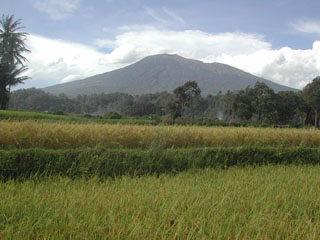Report on Marapi (Indonesia) — 19 February-25 February 2025
Smithsonian Institution / US Geological Survey
Weekly Volcanic Activity Report, 19 February-25 February 2025
Managing Editor: Sally Sennert.
Please cite this report as:
Global Volcanism Program, 2025. Report on Marapi (Indonesia) (Sennert, S, ed.). Weekly Volcanic Activity Report, 19 February-25 February 2025. Smithsonian Institution and US Geological Survey.
Marapi
Indonesia
0.38°S, 100.474°E; summit elev. 2885 m
All times are local (unless otherwise noted)
The Pusat Vulkanologi dan Mitigasi Bencana Geologi (PVMBG) reported that the seismic network at Marapi (on Sumatra) recorded an increase in volcanic earthquakes and tremors during early to mid-February. On 19 February white-and-gray ash plumes rose 200-700 m above the summit and drifted E. Webcam images at 0321 and 2056 showed incandesce at the summit. An eruptive event was recorded on 23 February, though no emissions were observed. On 24 February a dense gray ash plume rose 500 m above the summit and drifted E. The Alert Level remained at 2 (on a scale of 1-4) and the public was warned to stay 3 km away from the active crater.
Geological Summary. Gunung Marapi, not to be confused with the better-known Merapi volcano on Java, is Sumatra's most active volcano. This massive complex stratovolcano rises 2,000 m above the Bukittinggi Plain in the Padang Highlands. A broad summit contains multiple partially overlapping summit craters constructed within the small 1.4-km-wide Bancah caldera. The summit craters are located along an ENE-WSW line, with volcanism migrating to the west. More than 50 eruptions, typically consisting of small-to-moderate explosive activity, have been recorded since the end of the 18th century; no lava flows outside the summit craters have been reported in historical time.
Source: Pusat Vulkanologi dan Mitigasi Bencana Geologi (PVMBG, also known as CVGHM)

